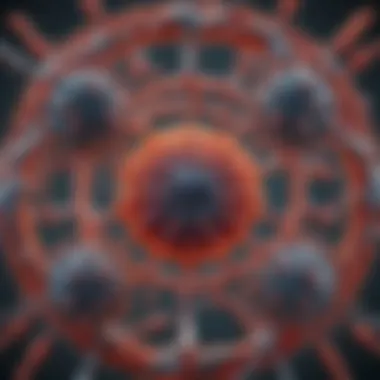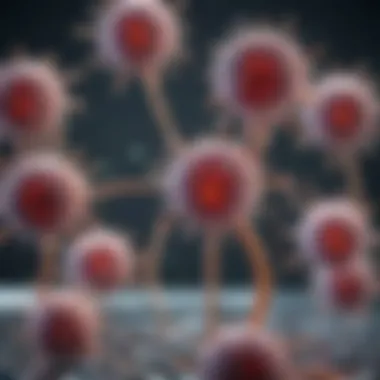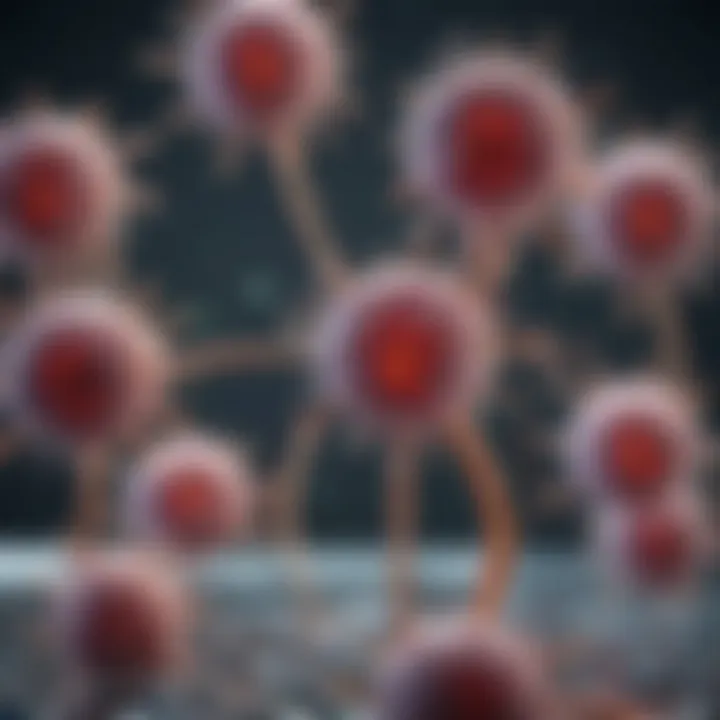Advancements in Retrovirus Therapy for Disease Treatment


Intro
The world of retrovirus therapy is emerging as one of the most pivotal arenas in modern medicine. Retroviruses, particularly known for their role in influencing human health, promise a transformative approach towards treating myriad diseases, with an accent on gene therapy and cancer. Their unique capabilities—to integrate their genetic material into host genomes—have garnered attention not just for their potential benefits but also for the challenges they present.
In the grand scheme of medical advancements, retroviruses serve as double-edged swords; they hold therapeutic potential while simultaneously posing risks. As we embark on this exploration, understanding the foundational elements of retrovirus biology is crucial, enabling healthcare professionals and researchers alike to better navigate the intricate avenues of this therapy.
Research Overview
Key Findings
Recent studies indicate that retrovirus therapy can enhance the delivery of therapeutic genes into target cells, thus empowering treatments for various illnesses. Notably, findings showcase how retroviruses facilitate gene transfer with a certain precision that traditional methods often lack.
- Effectiveness: Many trials have shown promising evidence of retroviral efficacy. For example, the use of Murine Leukemia Virus (MLV) as a vehicle for gene therapy has demonstrated significant potential in clinical settings, particularly concerning hereditary diseases.
- Challenges: However, while many studies accentuate their therapeutic potential, others bring forward concerns regarding insertional mutagenesis, which can lead to unintended consequences, such as cancerous growth.
Study Methodology
To understand the landscape of retrovirus therapy, a comprehensive review of literature spanning several clinical trials was undertaken. These trials elucidate varying methodologies:
- Randomized controlled trials focusing on gene therapy in hematological conditions.
- Observational studies assessing the long-term effects of retrovirus-based therapies.
By analyzing the outcomes from diverse patient groups, researchers can better grasp the therapeutic potential and challenges posed by retroviral agents.
Background and Context
Historical Background
Retroviruses aren’t a new entity in the realm of science. Their discovery can be traced back to the mid-20th century when researchers first identified their capability to alter cellular genetics. The HIV pandemic in the 1980s thrust retroviruses into the spotlight, urging scientists to investigate their implications in human diseases more rigorously. What started as an examination of viral behavior soon morphed into an exploration of therapeutic possibilities, laying the groundwork for future innovations.
Current Trends in the Field
Presently, the study of retrovirus therapy is at a remarkable threshold. With advances in molecular biology and technology, researchers are exploring more sophisticated methodologies to prevent and manage the risks associated. Some current trends include:
- Innovative Vector Design: Tailoring viral vectors to enhance specificity and safety.
- Combination Therapies: Integrating retrovirus therapy with other treatment modalities to bolster effectiveness and mitigate risks.
Engaging in these contemporary investigations may ultimately chart new pathways in the therapeutic landscape, pushing the boundaries of what retrovirus therapy can accomplish.
"The exploration of retroviral mechanisms offers critical insights into the ongoing evolution of therapeutic strategies in medicine."
Through this journey, we invite our readers—students, researchers, educators, and professionals—to delve deeper into the intricacies of retrovirus therapy, grasping not only its current implications but also its future prospects.
Understanding Retroviruses
Retroviruses are a unique group of viruses that hold a pivotal role in both basic biology and clinical applications. They possess the remarkable ability to integrate their genetic material into the host genome, fundamentally shifting how we perceive the interaction between viruses and human health. Understanding these entities is crucial, as their behaviors can help develop innovative therapies, particularly in combating diseases like cancer and genetic disorders.
The complexity of retroviruses necessitates a detailed exploration of their biological characteristics, classifications, and the therapeutic possibilities they offer.
Biological Characteristics
Structure of Retroviruses
The structure of retroviruses is distinct, comprising an envelope derived from the host cell membrane, which encases the viral genome and enzymes necessary for replication. This envelope is integral to their ability to infect new cells, as it helps the virus to evade the immune system. A significant characteristic is the presence of two identical strands of RNA, which outlines their retrograde action and facilitates their unique replication strategy.
This structural choice, which on the surface may seem a disadvantage due to reliance on host machinery, actually proves beneficial. It allows for high variability, making retroviruses adept at adapting to new environments and rendering them powerful tools in gene therapy.
Life Cycle of Retroviruses
The life cycle of a retrovirus begins with attachment to a host cell's receptor, followed by fusion and entry into the cell. Once inside, the viral RNA is reverse transcribed into DNA, a critical step that highlights their survival skills. This DNA is then integrated into the host’s genome, where it can remain dormant or be activated to produce new viral particles.
This action of integrating into the host DNA is a double-edged sword; while it permits sustained viral replication, it also raises concerns over potential disruptions to the host genome, leading to insertional mutagenesis. Nonetheless, understanding this lifecycle has paved the way for scholarly research into harnessing these processes for clinical use.
Genetic Material and Replication
Retroviruses utilize single-stranded RNA as their genetic material, which not only serves as a blueprint for protein synthesis but also plays a vital role during replication. The enzyme reverse transcriptase converts viral RNA to DNA, a mechanism that’s interesting given its potential implications in therapy designs. This unique form of genetic replication allows retroviruses to produce numerous copies quickly.
This process, while highly effective for viral propagation, introduces a conundrum regarding fidelity. The replication process is error-prone, leading to mutations that can either be a boon (in terms of adaptability) or a bane (in terms of stability). Thus, recognizing this aspect is essential to grasp the broader benefits and risks associated with retroviral therapies.
Classification of Retroviruses
Retroviruses are classified mainly into three categories, each with unique features and implications in the field of medicine. Understanding these classifications is crucial for addressing specific diseases through tailored approaches.
Oncoviruses
Oncoviruses are retroviruses known for their role in inducing cancers. They integrate into the host genome and can activate proto-oncogenes or inactivate tumor suppressor genes. Their study is particularly important as it provides insights into mechanisms of cellular transformation, identifying therapeutic targets for cancer treatment.


A distinctive aspect of oncoviruses is their ability to cause tumors in various animal models. This characteristic not only aids in research but also raises concerns about safety in therapeutic applications, as deliberate introduction of these viruses can have unforeseen consequences.
Lentiviruses
Lentiviruses, a subgroup of retroviruses, are characterized by their ability to infect non-dividing cells, making them particularly valuable in gene therapy contexts. The most well-known lentivirus is the Human Immunodeficiency Virus (HIV), which further sheds light on the complexities of viral pathogenesis and host interactions.
This ability to transduce cells makes lentiviruses a popular choice for gene delivery. However, the potential for immune response against the lentiviral proteins poses risks that researchers must navigate, balancing efficacy with patient safety.
Spumaviruses
Spumaviruses, while less understood, provide a unique perspective on retroviral biology. They are generally non-pathogenic, and their distinct replication strategy raises interesting questions regarding their use in gene therapy. Unlike other retroviruses, spumaviruses contain a unique gag gene that encodes unusual proteins. This uniqueness sparks curiosity about their potential applications; however, the limited understanding results in cautious exploration in practical therapeutics.
In summary, understanding retroviruses—through their structure, life cycle, genetic material, and classifications—shapes the foundation of retroviral therapy. This knowledge propels ongoing research, refining techniques, and harnessing the full potential of these remarkable viral agents.
Mechanisms of Retrovirus Therapy
The topic of mechanisms of retrovirus therapy is pivotal in comprehending how these innovative treatment strategies can be effectively utilized. Retroviruses, with their unique ability to integrate into host genomes, offer a compelling avenue for therapeutic gene delivery. As we explore this terrain, we unravel the potential benefits—such as targeted treatment options for genetic disorders and cancers—and the considerations regarding safety and regulatory frameworks. The understanding of the mechanisms at play is central to advancing these therapies and navigating the challenges that accompany them.
Gene Delivery Systems
Viral Vectors
Viral vectors are the workhorses of retroviral therapy; they play a critical role in the successful delivery of therapeutic genes into target cells. A standout characteristic of viral vectors is their innate ability to efficiently enter host cells and deliver genetic material with high precision. This feature makes them a widely favored choice for gene therapy. Their popularity can be attributed to how they mimic the natural infection process, thus ensuring a better uptake of the therapy.
One unique aspect of viral vectors is their capacity for modification. Researchers can tailor these vectors to enhance their specificity and reduce off-target effects, which can be advantageous in clinical applications. However, there are drawbacks to consider—such as the potential for an immune response to the viral components. This can lead to complications that could undermine the efficacy of the treatment.
Transduction Efficiency
Transduction efficiency is another cornerstone of retroviral therapy. This term refers to how effectively the viral vector can transfer genetic material into host cells. A high transduction efficiency is crucial for the success of any gene therapy procedure, ensuring that enough cells are modified to produce a therapeutic effect.
The appeal of examining transduction efficiency lies in its role in optimizing treatment protocols. For instance, certain viral strains have been shown to yield superior transduction rates, making them more effective in clinical settings. However, achieving balance is key, as higher transduction rates can also lead to increased unintended genetic alterations, posing risks to patient safety.
Tissue Targeting
Tissue targeting specializes in guiding therapeutic interventions to the specific tissues or organs where they are needed. This aspect is fundamental in retroviral therapy, as ensuring that the treatment reaches the right location enhances its effectiveness while mitigating off-target effects. A significant characteristic of tissue targeting is its ability to employ various ligands or antibodies that home in on specific cell types.
The distinctive feature of tissue targeting is its potential to customize treatments, thereby increasing their safety profiles and effectiveness. Nevertheless, achieving optimal tissue targeting can sometimes prove challenging. There is a fine line to walk between precision and efficiency, and any misstep may lead to inadequate treatment responses or adverse effects.
Therapeutic Gene Insertion
Gene Editing Techniques
Gene editing techniques represent a cutting-edge area in retrovirus therapy, with tools like CRISPR/Cas9 leading the charge. These techniques have revolutionized the landscape of genetic modifications, allowing for precise changes to be made at specific loci. The beauty of gene editing lies in the control it offers researchers, enabling them to delete, insert, or alter genes with remarkable accuracy.
One key characteristic of these techniques is their adaptability; they can be customized for various therapeutic applications. In the realm of retroviral therapy, gene editing can be used to correct genetic defects or enhance cell functions. However, precision comes with its challenges. The risk of off-target effects—where unintended genomic alterations occur—has raised concerns, necessitating careful optimization and thorough testing.
Insertional Mutagenesis Risks
Insertional mutagenesis refers to a potential risk associated with the integration of therapeutic genes into the host genome. While essential for ensuring the stability of gene therapies, this process can inadvertently activate unwanted genes or disrupt crucial regulatory regions, leading to consequences such as oncogenesis. Understanding the risks of insertional mutagenesis is vital for enhancing the safety of retroviral therapies.
The noteworthy concern here is that while viral vectors efficiently integrate genetic material, they do not always discriminate about where this happens. This indiscriminate nature raises red flags, especially in the context of cancer therapies. Therefore, ongoing research is focused on developing safer integration strategies that minimize such risks while maintaining therapeutic efficacy.
Regulatory Considerations
Finally, regulatory considerations surrounding retrovirus therapy play an indispensable role in ensuring that therapeutic interventions are both safe and effective. The regulatory landscape continues to evolve, reflecting the rapid advancements in gene therapy technologies. A significant aspect of these considerations is compliance with ethical standards to protect patient welfare.
One of the important features here is the necessity for comprehensive preclinical and clinical testing, ensuring all potential risks are identified and mitigated. Furthermore, as therapies continue to emerge, regulatory bodies are adjusting frameworks to accommodate innovative approaches. However, the process can sometimes be cumbersome, potentially delaying the availability of promising therapies.
"The complexity of genetic modifications calls for a nuanced understanding of regulatory guidelines to ensure public safety and scientific integrity."
Applications in Medicine
The application of retrovirus therapy in the medical field opens up a whole new frontier for treating various conditions that were once deemed incurable. Retroviruses, with their innate ability to integrate into the host genome, offer unique therapeutic possibilities. Exploring these applications provides insight into how retroviral vectors can be utilized, leading to promising interventions for diseases, particularly cancer and inherited disorders. As we delve deeper, we see the spectrum of benefits, ranging from innovative treatment approaches to personalized medicine, all while grappling with essential considerations such as safety and ethics.
Cancer Treatment
Immunotherapy Approaches
Immunotherapy represents a powerful approach in cancer treatment that leverages the body's immune system to target and destroy cancer cells. A key characteristic of immunotherapy is its target specificity, which differs from traditional therapies that indiscriminately attack all rapidly dividing cells. What makes immunotherapy particularly attractive is its potential for less collateral damage—patients experience significantly fewer side effects compared to conventional chemotherapy. This specificity is driven by the understanding of tumor antigens that immune cells can recognize and attack, distinguishing cancerous cells from healthy ones.
However, the unique feature of immunotherapy arises from its varied approaches, such as CAR-T cell therapy, where T cells are engineered to better fight cancer. While this technique shows great promise, it does carry risks, including severe immune responses, and the fact that its effectiveness varies among patients and tumor types.
Targeting Tumor Cells
Targeting tumor cells is pivotal in the context of retroviral therapy. This method focuses on ensuring that the therapeutic treatment is concentrated on cancer cells while sparing healthy tissues. The main advantage lies in the ability of retroviruses to selectively infect dividing cells, often aligning with the characteristics of tumor cells. This makes targeting tumor cells a sought-after method in enhancing treatment efficacy.


A unique aspect of this targeting is the precision offered by the use of engineered retroviral vectors. They can be designed to express cytotoxic genes specifically within tumor cells, reducing systemic toxicity and improving patient outcomes. However, challenges persist, such as ensuring that the therapy does not inadvertently affect surrounding healthy cells, highlighting the need for rigorous testing and evaluation.
Clinical Trials and Results
The landscape of clinical trials surrounding retrovirus therapy is both expansive and revealing. These trials serve a dual purpose—they not only test the safety and efficacy of new therapeutics but also provide invaluable data that can guide further developments. A significant characteristic of these trials is the diverse methodologies employed, from Phase I trials assessing safety to Phase III trials evaluating long-term effectiveness.
The results from these trials have been instrumental in shaping understanding of retrovirus therapy's potential. For instance, numerous trials have shown remarkable responses in patients with hematologic malignancies treated with engineered retroviruses. Nevertheless, the results can vary greatly between individuals, emphasizing the importance of tailoring treatments to specific patient profiles and presenting potential setbacks to the overall applicability of these therapies in broader patient populations.
Inherited Disorders
Cystic Fibrosis
Cystic fibrosis (CF) is a genetic disorder caused by mutations in the CFTR gene, leading to severe respiratory and digestive issues. Retrovirus therapy has the potential to offer transformative pathways for treatment by delivering corrected versions of the CFTR gene directly to affected cells. The critical characteristic of this application lies in its focus on rectifying the underlying genetic defect rather than just managing symptoms, which is often the case in traditional treatments.
The unique feature of retroviral approaches to CF comes from the possibility of achieving a long-lasting therapeutic effect by integrating the corrected gene into the patient’s genome. However, long-term safety remains a concern, particularly regarding the potential for insertional mutagenesis, where the integration of a foreign gene could lead to unintended genetic consequences.
Sickle Cell Disease
Sickle cell disease (SCD) is another inherited disorder where retroviral therapy is carving out a niche by targeting the underlying genetic mutation. The essence of retroviral therapy in SCD is its ability to introduce a normal hemoglobin gene into the patient’s hematopoietic stem cells. This paves the way for producing healthy red blood cells, drastically decreasing disease symptoms.
One compelling aspect of this approach is the potential for patients to return to a more normal life, freed from the burdens of frequent hospital visits and debilitating pain episodes. Still, the challenges associated with this therapy include the appropriate sourcing of stem cells and ensuring that the modified cells persist long enough to achieve significant results, thus necessitating thorough research and patient-centric strategies.
Strategic Considerations
When evaluating the applications of retroviral therapy, several strategic considerations come into play. This includes understanding the patient’s individual genetic makeup, the stage of the disease, and previous treatment responses. Crafting strategies that acknowledge these factors is crucial in maximizing therapeutic outcomes.
Moreover, a key characteristic of successful implementation is collaboration amongst researchers, clinicians, and patients. Engaging patients throughout the treatment journey addresses the uncertainties that come with gene therapies and focuses on informed consent as a pivotal part of the process. The unique feature of integrating patient feedback ensures that trials are not just scientifically sound but also morally and ethically robust, ultimately leading to a more comprehensive understanding of the benefits and risks involved.
"The landscape of retrovirus therapy is not solely a scientific endeavor; it is a tapestry woven from the threads of ethics, innovation, and patient engagement."
In summary, the applications of retrovirus therapy in both cancer treatment and inherited disorders highlight the potential for groundbreaking advancements in medical science. Addressing the complexities of these therapies is essential for unlocking their full promise and ensuring they achieve their desired results in clinical settings.
Challenges of Retrovirus Therapy
Addressing the challenges of retrovirus therapy is of utmost importance in understanding its viability and future potential within the broader field of medicine. These challenges can reveal a great deal about the safety, effectiveness, and ethical considerations surrounding these therapies. In highlighting areas such as safety concerns and regulatory frameworks, we can create a clearer picture about what needs to be addressed in order to harness the immense possibilities retroviral therapy holds.
Safety Concerns
Safety concerns encompass a wide array of issues that researchers must confront when developing retroviral therapies. The potential for unintended consequences often raises caution.
Immune Response
A crucial aspect of immune response in the context of retroviral therapy is how the body reacts to foreign viral elements introduced through treatment. This response can be quite varied. On one hand, a robust immune reaction can be beneficial by eliminating target cells effectively. On the other hand, unwanted activation of the immune system may lead to adverse effects, such as tissue damage. One unique feature of immune response is its dual nature; it can act both as a defender against disease and as a potential source of complications.
- Advantages: A strong immune response could enhance the efficiency of retroviral therapies by ensuring that introduced genes are more readily accepted into the host organism.
- Disadvantages: However, this same immune response can result in significant side effects, complicating the therapeutic landscape.
Off-Target Effects
Off-target effects are another major concern in retroviral therapy. They occur when the therapeutic intervention inadvertently alters non-target genes, leading to potential complications.
- Key Characteristic: The essence of off-target effects is their unpredictable nature, which poses risks to treatment efficacy and patient health.
- Advantages: Identifying and mitigating these risks can lead to more refined therapies, minimizing collateral damage in treatment plans.
- Disadvantages: Nevertheless, the challenge remains to distinguish between useful and harmful modifications, which complicates the entire therapy process.
Reactivation of Endogenous Retroviruses
Reactivation of endogenous retroviruses is a particularly troubling issue. This phenomenon entails the activation of retroviral sequences that are naturally present in the genome of an individual, which can be prompted by therapy.
- Key Characteristic: The presence of these sequences can lead to complications that were previously dormant, highlighting the intricate nature of interactions between therapy and the host genome.
- Advantages: Investigating this reactivation can shed light on potential pathways for preventing disease recurrence or aiding in therapeutic efficacy.
- Disadvantages: However, it also presents a double-edged sword by risking long-term health complications for patients, underlining the need for thorough understanding before treatments are widely adopted.
Regulatory Framework
The regulatory framework surrounding retrovirus therapy plays a pivotal role in shaping its development and implementation in clinical settings. Establishing clear policies is essential to ensure both safety and efficacy while maintaining public trust.
Policy Development
Developing robust policies is crucial in guiding research and clinical application of retrovirus therapy. Effective policy development focuses on balancing innovation with patient safety.
- Key Characteristic: One significant aspect of policy development is ongoing evaluation and adaptation as new findings arise within the field.
- Advantages: Well-crafted policies can drive research while ensuring ethical standards are upheld.
- Disadvantages: However, overly stringent regulations may stifle innovation by making it harder for researchers to explore new therapeutic avenues.
Ethical Considerations
Ethical considerations are paramount in the discourse surrounding retroviral therapies. They encompass a broad spectrum of issues, from informed consent to the implications of genetic modification.
- Key Characteristic: Ethical considerations often revolve around the potential consequences of modifying genetic material, raising critical questions about long-term impacts and societal acceptance.
- Advantages: Addressing these issues head-on aids in fostering responsible science and ensuring that therapies benefit patients without causing unintended consequences.
- Disadvantages: Nonetheless, navigating ethical waters can prove complex, sometimes delaying promising therapies from reaching those in need.


Informed Consent Protocols
Informed consent protocols are essential for ensuring that patients are fully aware of the risks and benefits of participating in retroviral therapy trials.
- Key Characteristic: A solid informed consent process includes comprehensive education on potential outcomes, both positive and negative.
- Advantages: This not only builds trust but also empowers patients to actively engage in their treatment choices.
- Disadvantages: However, if not executed appropriately, there is a risk of patients feeling overwhelmed or confused by the information presented, potentially resulting in poor decision-making.
Advancements in Retroviral Research
The realm of retroviral research is witnessing rapid evolution, paving the way for groundbreaking advancements in medical technologies. These advancements are crucial not only for theoretical exploration but for practical applications that hold the potential to change the landscape of treatment options available today. Retroviruses, due to their distinct characteristics and ability to integrate into the host genome, offer unique therapeutic pathways. As new methodologies emerge, understanding their contributions and implications becomes paramount.
Innovative Approaches
Novel AI in Therapy Design
Artificial Intelligence is making a significant impact in the field of therapy design. The integration of novel AI systems allows for more efficient data analysis and predictive modeling in retroviral therapy. The sophisticated algorithms can sift through vast datasets, identifying patterns that may not be visible to the human eye. This capability enhances the design of targeted therapies, ultimately improving success rates.
A key characteristic of AI in therapy design is its adaptability. Unlike traditional methods, AI continuously learns and refines its models based on new data, which makes it a valuable tool for researchers. However, a unique feature of AI is its reliance on data quality—insufficient or biased data may lead to inaccurate predictions. In this sense, while AI broadens possibilities, it also calls for stringent data validation measures. The advantage here is the potential for personalized treatment regimens, tailoring therapies to the genetic makeup of individuals.
Personalized Retroviral Therapy
Personalized Retroviral Therapy is emerging as a beacon of hope in treating complex conditions like cancers and genetic disorders. This approach focuses on customizing treatment based on individual patient profiles, particularly their genetic information. The hallmark of this therapy is its patient-centric design, aiming to maximize efficacy while minimizing adverse effects.
What makes Personalized Retroviral Therapy a popular choice is its capacity for precision. By analyzing a patient’s genetic data, healthcare providers can develop specific retroviral vectors that optimally target affected tissues. However, the disadvantage lies in the need for extensive genomic information, which may not be available or feasible in all cases. Moreover, developing tailored therapies can also be resource-intensive, potentially limiting accessibility for many patients. But, the upside is clear—this method holds the promise of higher success rates and fewer side effects.
Combination Therapies
Combination Therapies represent an innovative strategy in retroviral treatments by integrating multiple therapeutic modalities. This holistic approach can enhance treatment outcomes, particularly in patients with complex diseases. In essence, utilizing retroviruses alongside other treatments can potentiate effects, leading to better control of disease progression.
One notable characteristic of this strategy is its versatility. Combination Therapies allow for synergistic effects, utilizing the strengths of different modalities in mutually beneficial ways. This makes them a beneficial choice in situations where single treatments may fall short. An example could be combining retroviral therapy with immunotherapies to boost the immune response against tumors. On the flip side, the complexity of managing multiple therapies can lead to increased risks of side effects or drug interactions. Additionally, there is a need for careful patient monitoring to ensure effectiveness and safety. Nonetheless, the potential to achieve a more comprehensive treatment outcome keeps Combination Therapies at the forefront of research in retrovirus therapy.
Future Directions
Integrating with Other Modalities
Integrating retroviral therapies with other treatment modalities has significant implications for future medical practices. This approach encourages a multidisciplinary mindset, merging insights from virology, gene therapy, and immunology. The distinctive characteristic here is the fusion of expertise, fostering innovative solutions that might not emerge within a single discipline.
What makes this integration compelling is that it holds promise to address challenges that each modality faces independently. For example, combining retroviruses with cutting-edge CRISPR technology can amplify therapeutic effects. The advantage of such integration could lead to enhanced efficacy in treating diseases like cancer, where both genetic modification and viral infection are used to combat tumors. However, careful consideration of potential interactions between therapies is crucial to avoid unintended consequences.
Global Collaboration Initiatives
Global Collaboration Initiatives play an essential role in advancing retroviral research. These initiatives unite researchers from various backgrounds and countries, pooling resources and sharing knowledge. The key characteristic of these collaborations is their ability to foster diverse perspectives, facilitating a more comprehensive understanding of retroviruses and their therapeutic potential.
Emphasizing collaboration not only speeds up research but also democratizes access to innovations, making breakthroughs available globally. The disadvantage, however, may arise from differences in regulations, cultural approaches, and funding environments across regions. Yet, the advantages far outweigh these hurdles, as such partnerships can lead to more robust and scientifically valid results, ensuring broader and equitable access to new therapies.
Translational Research
Translational Research serves as the bridge connecting laboratory discoveries to real-world applications. In the context of retroviral therapy, it focuses on converting novel findings into viable treatment options. The key characteristic of this approach is its emphasis on practical application within clinical settings, significantly benefiting patient outcomes.
The unique feature of Translational Research lies in its iterative process; researchers continuously refine their methodologies based on clinical feedback. This ensures that therapies not only work in theory but also in practice, showing real-world effectiveness. The disadvantage can be the long timelines required for thorough testing and validation, which may delay access to promising treatments. Still, the potential for effective interventions justifies the investment, reaffirming its position as a cornerstone in advancing retroviral therapy.
Ethical and Societal Implications
When discussing retrovirus therapy, it's crucial to bring to light the ethical and societal implications that accompany this scientific advancement. While these therapies hold promise in treating diseases that have long evaded effective treatment, they don't come without their own set of concerns. The benefits of improved health outcomes must be weighed against potential ethical dilemmas that could arise from their implementation. Consideration of public perception can guide the dialogue around risks and benefits, ensuring that trust and understanding accompany scientific progress.
Public Perception
Understanding Risks and Benefits
Understanding risks and benefits plays a pivotal role in shaping how the public views retrovirus therapy. People often worry about the unknowns—how these therapies will affect not just individual patients but the larger community. This concern is rooted in the very nature of retroviruses and their ability to integrate into host DNA, which can lead to unpredictable outcomes. However, clear communication of the evidence supporting the benefits, such as targeted therapies for illnesses like cancer, can help mitigate fears. The key characteristic of this understanding is its dual focus: it recognizes both the scientific potential and the public's legitimate concerns. Importantly, fostering this understanding allows for a more informed public discussion, leading to more educated decisions about embracing these therapies.
Communication Strategies
Effective communication strategies are essential to convey information about retrovirus therapy. Transparent communication can help counteract the fear stemming from misinformation. Utilizing simple, relatable language rather than overly technical terms can bridge the gap between scientists and the general populace. One advantage of strong communication strategies is that they can break down complex topics into digestible pieces, enabling people to grasp the science behind retroviral therapies. However, the challenge lies in ensuring the information is consistent, accurate, and devoid of sensationalism. In truth, a strong communication plan not only informs but empowers patients and their families, fostering a sense of agency amidst uncertainty.
Cultural Perspectives
Cultural perspectives surrounding retrovirus therapy also come into play. Different cultures may hold varying beliefs regarding medical innovation, which can influence how individuals view such therapies. In some societies, there may be a deep-rooted skepticism toward biomedical interventions, leading to resistance against treatments perceived as invasive. This variation underscores the key characteristic that cultural context can significantly alter the acceptance of therapeutic advances. Understanding these cultural nuances can be beneficial for healthcare providers in tailoring their approach. Addressing cultural perspectives enriches the dialogue around retrovirus therapy, providing a more holistic view that acknowledges diverse experiences and attitudes.
Access and Equity
Barriers to Access
Barriers to access are perhaps one of the most pressing issues when it comes to retrovirus therapy. Not everyone has equal access to cutting-edge treatments, which can create significant disparities among different socioeconomic groups. The high costs associated with these therapies can prevent many from receiving potentially life-saving treatments. Additionally, geographical barriers may limit access to centers specializing in retroviruses. Recognizing these disheartening realities is essential in our approach to implementing retroviral therapies. By highlighting the importance of equitable access, we foster a system where therapies are available to all who need them, regardless of their financial or social status.
Policy Recommendations
Policy recommendations must be crafted to address the barriers identified above. Advocating for policies that promote resource allocation toward equitable access can ensure that retrovirus therapies don't become tools of division. Supportive policies can encourage research funding and affordability initiatives to maximize treatment reach. The characteristic nature of these policies makes them valuable in not only levelling the playing field but also enhancing the overall public health. Still, policymakers must navigate the complex landscape of funding and resource distribution carefully, as missteps could perpetuate existing inequalities.
Global Health Disparities
Global health disparities represent a significant challenge in the implementation of retrovirus therapy. Health interventions that thrive in developed nations may fail to transition effectively to developing countries due to systemic health inequities. The key characteristic here is the recognition that health isn't merely about individual countries but rather a global network of challenges that affect interconnected populations. Addressing these discrepancies is vital to ensuring that advancements are utilized universally, rather than being a privilege of the few. The unique feature of addressing global health disparities is that it opens the door to collaboration—fostering a global community willing to tackle health issues together. Failure to do so not only hinders progress but risks leaving portions of the population without critical life-saving therapies.







